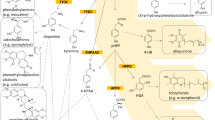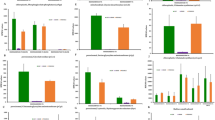Summary
-
1.
The formation of enzymes of the oxidative and reductive pentose phosphate cycle was followed in developing rye seedlings. Ribulose diphosphate carboxylase and transketolase are absent in dry seeds; ribose phosphate isomerase is found only in trace amounts. In light as well as in the dark transketolase and ribose phosphate isomerase increase immediately after the onset of germination, whereas ribulose diphosphate carboxylase appears later. Remarkably the latter enzyme is also formed in completely dark-grown seedlings. At this stage isolated thylakoids are already present in the proplastids. The formation of these enzymes of the Calvincycle is promoted by light.
-
2.
The formation of ribulose diphosphate carboxylase and transketolase is strongly suppressed by low temperature or chloramphenicol. Chloramphenicol also inhibits the growth of proplastids and prevents the formation of thylakoids but not of prolamellar bodies.
-
3.
Glucose-6-phosphate dehydrogenase, phosphogluconate dehydrogenase, and shikimate dehydrogenase are already present in the dry embryo. At the beginning of seedling development there is a rapid increase in glucose-6-phosphate dehydrogenase. In the shoots the rate of this increase levels off at the moment when ribulose diphosphate carboxylase appears. This decrease in the rate of formation of glucose-6-phosphate dehydrogenase is not due to a lack of nutrients, but must be caused by a specific regulation.
-
4.
When the formation of ribulose diphosphate carboxylase is prevented by low temperature or chloramphenicol, the increase of glucose-6-phosphate dehydrogenase continues at a constant rate. It is concluded that the formation of glucose-6-phosphate dehydrogenase is suppressed by factors which appear when enzymes of the Calvin-cycle are formed. This effect of low temperature is not directly connected with vernalisation phenomena.
-
5.
The results suggest that the oxidative pentose phosphate cycle plays a special role in heterotrophic growth.
Similar content being viewed by others
Literatur
Anderson, D. G., H. A. Stafford, E. E. Conn, and B. Vennesland The distribution in higher plants of triphosphopyridine nucleotide-linked enzyme systems capable of reducing glutathione. Plant Physiol. 27, 675–684 (1952).
Axelrod, B., and R. S. Bandurski: Oxidative metabolism of hexose phosphates by higher plants. Fed. Proc. 11, 182 (1952).
Barnett, R. C., H. A. Stafford, E. E. Conn, and B. Vennesland: Phosphogluconic dehydrogenase in higher plants. Plant Physiol. 28, 115–122 (1953).
Bartels, H.: Enzymaktivitäten in ruhenden und keimenden Samen von Pinus nigra Arn. Planta (Berl.) 55, 573–597 (1960).
Beevers, L., and R. H. Hageman: The mechanism of induction of nitrate reductase in higher plants. Plant Physiol. 38, Suppl. XXXII (1963).
Böger, P.: Das Strukturproteid aus Chloroplasten einzelliger Grünalgen und seine Beziehung zum Chlorophyll. Flora (Jena) 154, 174–211 (1964).
Chakravorty, M., and D. P. Burma: Enzymes of the pentose phosphate pathway in the mung-bean seedling. Biochem. J. 73, 48–53 (1959).
Döbel, P.: Untersuchung der Wirkung von Streptomycin-, Chloramphenicol- und 2-Thiouracil-Behandlung auf die Plastidenentwicklung von Lycopersicum esculentum Miller. Biol. Zbl. 82, 275–295 (1963).
Eisenstadt, J. M., and G. Brawerman: The protein-synthesizing systems from the cytoplasm and chloroplasts of Euglena gracilis. J. molec. Biol. 10, 392–402 (1964).
Feierabend, J.: Differenzierungsmuster und Regulationsvorgänge im Enzymsystem von Roggenkeimlingen. Diss. Göttinge 1965.
— u. A. Pirson: Die Wirkung des Lichts auf die Bildung von Photosyntheseenzymen in Roggenkeimlingen. Z. Pflanzenphysiol. 55, 235–245 (1966).
Gibbs, M.: Triosephosphate dehydrogenase and glucose-6-phosphate dehydrogenase in the pea plant. Nature (Lond.) 170, 164 (1952).
Gibor, A. and S. Granick: Plastids and mitochondria: inheritable systems. Science 145, 890–897 (1964).
Goksöyr, J., E. Boeri, and R. K. Bonnichsen: The variation of ADH and catalase activity during the germination of the green pea (Pisum sativum). Acta chem. scand. 7, 657–662 (1953).
Hageman, R. H., and D. I. Arnon: Changes in glyceraldehydephosphate dehydrogenase during the life cycle of green plant. Arch. Biochem. Biophys. 57, 421–436 (1955).
—, and D. Flesher: Nitrate reductase activity in corn seedlings as affected by light and nitrate content of nutrient media. Plant Physiol. 35, 700–708 (1960).
——, and D. Flesher: The effect of an anaerobic environment on the activity of alcohol dehydrogenase and other enzymes of corn seedlings. Arch. Biochem. Biophys. 87, 203–209 (1960).
Hall, D. O., R. C. Huffaker, L. N. Shannon, and A. Wallace: Influence of light on dark carboxylation reactions in etiolated barley leaves. Biochim. biophys. Acta (Amst.) 35, 540–542 (1959).
Haskins, F. A.: Changes in the activities of several enzymes during germination and seedlings development in corn (Zea mays L.). Plant Physiol. 30, 74–78 (1955).
Heber, U., N. G. Pon, and M. Heber: Localization of carboxydismutase and triosephosphate dehydrogenases in chloroplasts. Plant Physiol. 38, 355–360 (1963).
—, u. K. A. Santarius: Pyridinnucleotide in Chloroplasten und Zytoplasma von Blattzellen im Licht und im Dunkeln. In: Currents in photosynthesis. Proc. 2. West.-Europe Conf. Photos., ed. by J. B. Thomas and J. C. Goedheer, p. 393–400. Rotterdam: Donker-Publ. 1966.
Hotta, Y., and H. Stern: Transient phosphorylation of deoxyribosides and regulation of deoxyribonucleic acid synthesis. J. biophys. biochem. Cytol. 11, 311–319 (1961).
Hudock, G. A., G. C. McLeod, J. Moravkova-Kiely, and R. P. Levine: The relation of oxygen evolution to chlorophyll and protein synthesis in a mutant strain of Chlamydomonas reinhardi. Plant Physiol. 39, 898–903 (1964).
Huffaker, R. C., R. B. Obendorf, C. J. Keller, and G. E. Kleinkoff: In vivo light stimulation of carboxylative phase enzyme activities in greening barley seedlings. Plant Physiol. 39, Suppl. XIV (1964).
Huth, W.: Enzymatische Untersuchungen an Grünalgen bei verschiedenen Formen der Kohlenstoffernährung. Diss. Göttingen 1965.
Klein, S.: The effect of low temperature on the development of the lamellar system in chloroplasts. J. biophys. biochem. Cytol. 8, 529–539 (1960).
Kotzé, J. P. u. E. Latzko: Aktivitätswechsel von Enzymen der Glykolyse sowie des Citrat- und Pentosephosphatcyklus in keimender Sommergerste. Z. Pflanzenphysiol. 53, 320–333 (1965).
Marcus, A.: Photocontrol of formation of red kidney bean leaf triphosphopyridine nucleotide linked triosephosphate dehydrogenase. Plant Physiol. 35, 126–128 (1960).
Margulies, M. M.: Effect of chloramphenicol on light-dependent synthesis of proteins and enzymes of leaves and chloroplasts of Phaseolus vulgaris var. Black Valentine. Plant Physiol. 39, 579–585 (1964).
—: Relationship between red light mediated glyceraldehyde-3-phosphate dehydrogenase formation and light dependent development of photosynthesis. Plant Physiol. 40, 57–61 (1965).
Marschner, H., u. I. Günther: Veränderungen der Feinstruktur der Chloroplasten in Gerstensprossen unter dem Einfluß von Cäsium. Flora (Jena) A 156, 684–696 (1966).
Molotskovsky, J. G., and V. F. Moriakova: The role of nucleic acids and protein in induced chlorophyll biosynthesis. Izv. Akad. Nauk S.S.R., Ser. Biol. 28, 719–723 (1963). Nach Ber. wiss. Biol. 213, 106 (1964).
Oota, Y., Y. Yamamoto, and R. Fujii: Dehydrogenase pattern in bean seed embryo. J. Biochem. 40, 187–203 (1953).
Paigen, K.: Changes in the inducibility of galactokinase and β-galactosidase during inhibition of growth in Escherichia coli. Biochim. biophys. Acta (Amst.) 77, 318–328 (1963).
Paleg, L. G.: Physiological effects of gibberellic acid. II. On starch hydrolyzing enzymes of barley endosperm. Plant Physiol. 35, 902–906 (1960).
—: Physiological effects of gibberellins. Ann. Rev. Plant Physiol. 16, 291–322 (1965).
Parthier, B.: Chloramphenicol-Wirkung auf eine durch Licht stimulierte Proteinsynthese in Blättern und in isolierten Chloroplasten. Z. Naturforsch. 20b, 1191–1197 (1965).
Robinson, E., and R. Brown: The development of the enzyme complement in growing root cells. J. exp. Bot. 3, 356–374 (1952).
Rossner, W.: Licht- und elektronenoptische Untersuchungen über den Einfluß von Streptomycin auf Sinapis alba L. Protoplasma (Wien) 52, 580–610 (1960).
Sen, N. P., and A. D. Robinson: The absence of thiamine phosphates from cereals. Canad. J. Biochem. Physiol. 41, 97–100 (1963).
Smillie, R. M., W. R. Evans, and H. Lyman: Metabolic events during the formation of a photosynthetic from a nonphotosynthetic cell. Meristems and differentiation. Brookhaven Symposia Biol. 16, 89–108 (1963).
Stubbe, W.: Die Plastiden als Erbträger. 3. Wiss. Konf. Ges. Dtsch. Naturf. u. Ärzte. Berlin-Heidelberg-New York: Springer 1966.
Sypherd, P. S., N. Strauss, and H. P. Treffers: The preferential inhibition by chloramphenicol of induced enzyme synthesis. Biochem. biophys. Res. Commun. 7, 477–481 (1962).
Tolbert, N. E., and F. B. Gailey: Carbon dioxide fixation by etiolated plants after exposure to white light. Plant Physiol. 30, 491–499 (1955).
Varner, J. E., and G. R. Chandra: Hormonal control of enzyme synthesis in barley endosperm. Proc. nat. Acad. Sci. (Wash.) 52, 100–106 (1964).
Wanka, R., I. K. Vasil, and H. Stern: Thymidine kinase: the dissociability and its bearing on the enzyme activity in plant materials. Biochim. biophys. Acta (Amst.) 85, 50–59 (1964).
Wettstein, D. v.: The formation of plastid structures. The photochemical apparatus, its structure and function. Brookhaven Symposia Biol. 11, 138–159 (1958).
Author information
Authors and Affiliations
Rights and permissions
About this article
Cite this article
Feierabend, J. Enzymbildung in Roggenkeimlingen Während der Umstellung von Heterotrophem auf Autotrophes Wachstum. Planta 71, 326–355 (1966). https://doi.org/10.1007/BF00396320
Received:
Issue Date:
DOI: https://doi.org/10.1007/BF00396320




